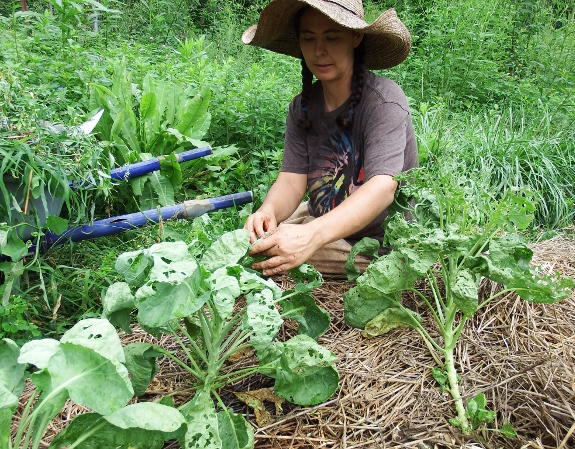
Brussels sprouts under row covers revisited

I thought that planting
brussels sprouts early, kill mulching around them to keep down weeds,
then covering
them up with a row cover to beat cabbageworms would
create a set-it-and-forget-it fall crop. But I should have realized
nothing is really set-it-and-forget-it in the garden.
When the lumps under the
row cover stopped looking regular, I finally removed the fabric and
took a look. Many plants had been stunted and two thirds of them had
outright died, leaving us about as many good plants as last year.
What was the culprit?
One of our cats jumped on the row cover and broke a hole in the area
pictured above...and that turned out to be the healthiest part of the
row (except for holes in leaves from sneaky cabbageworms). As a result,
my guess is that the row cover heated up the plants too much, causing
some to flounder and others to perish. Looks like we'll have to go back
to the usual bug-squishing routine in future!
Want more in-depth information? Browse through our books.
Or explore more posts by date or by subject.
About us: Anna Hess and Mark Hamilton spent over a decade living self-sufficiently in the mountains of Virginia before moving north to start over from scratch in the foothills of Ohio. They've experimented with permaculture, no-till gardening, trailersteading, home-based microbusinesses and much more, writing about their adventures in both blogs and books.
Want to be notified when new comments are posted on this page? Click on the RSS button after you add a comment to subscribe to the comment feed, or simply check the box beside "email replies to me" while writing your comment.

Instead of remay, even the lightest of which does increase temperatures underneath, I've had success with insect netting. Johnny's carries a variety, but I prefer the ProtekNet from Dubois Agrinovation. I've used it on many things, including my young trees to protect them from Japanese beetles.
For my Brussels sprouts, however, I don't cover, and if the cabbage moths get bad, I sprinkle the leaves with self-rising flour. The caterpillars ingest it, and when the sun hits them, they, uh, explode.